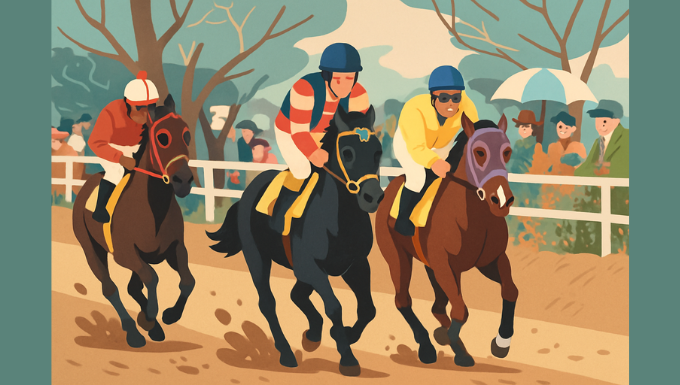Understanding horse racing form is key to making smart picks. It’s like having a roadmap to a horse’s past runs, strengths, and potential. To the uninitiated, it looks like a wall of numbers and abbreviations. To us, it’s the story of the race, waiting to be read.

What Is Horse Racing Form?
Horse racing form is a summary of a horse’s recent performances. It’s usually found in race cards, newspapers, or online betting sites. Think of it as a report card that shows how the horse has done in previous races. This info helps you spot patterns, like if a horse performs well on certain tracks or distances.
Form lines include details such as the horse’s name, age, weight, jockey, trainer, and a string of numbers and letters from past races. For example, you might see something like “1-234F” that’s code for the horse’s finishing positions and any incidents.
Key Elements of a Form Card
Let’s go through the main parts of a typical form card. I’ll use simple examples to explain each one.
1. Basic Horse Info
- Name and Age: The horse’s name is obvious, but age matters. Younger horses (2-4 years old) might improve quickly, while older ones could be more consistent.
- Sex and Color: Marked as g (gelding), m (mare), c (colt), etc. Geldings often run steadily without hormones getting in the way.
- Sire and Dam: These are the parents. If the sire was a champion sprinter, the horse might excel in short races.
2. Past Performance Line
This is the heart of the form – a sequence like “312U-45P”. Each symbol tells a story:
- Numbers (1-9): Finishing position. “1” means first place, “2” second, and so on. Higher numbers like “0” often mean 10th or worse.
- Letters for Incidents:
- F: Fell during the race.
- U: Unseated the rider.
- P: Pulled up (stopped by the jockey).
- R: Refused to jump.
- B: Brought down by another horse.
- Hyphens and Slashes: A hyphen separates seasons (e.g., “123-45” means last season’s results before the hyphen). A slash might indicate a change in race type.
Look for trends. A string of 1s and 2s shows a horse in good shape. If it’s all high numbers lately, the horse might be out of form.
3. Race Details from Past Runs
Under each form entry, you’ll see specifics:
- Date and Track: Check if the horse likes the track. Some do better on flat turf vs. hilly courses.
- Distance: Measured in furlongs (e.g., 5f for 5 furlongs). Match this to today’s race – a horse that wins at 6f might struggle at 12f.
- Going: Ground conditions like firm (good weather) or soft (after rain). Horses have preferences; mud-lovers shine on heavy going.
- Class: Races are graded (e.g., Class 1 is top level). A horse dropping from Class 2 to Class 4 might have an edge against weaker competition.
- Weight Carried: In handicaps, horses carry weights to level the field. Lighter weights can help.
4. Jockey and Trainer Stats
- Jockey: Look for win percentages. A top jockey like Frankie Dettori can make a difference.
- Trainer: Some trainers specialize in certain races. Check their strike rate (wins per run).
5. Ratings and Odds
- Official Rating (OR): A number from racing authorities, like 80-120. Higher means better ability. In handicaps, compare OR to rivals.
- Betting Odds from Past Races: If a horse was favored (low odds) but lost, dig into why. Maybe bad luck?
Step-by-Step Guide to Reading Form
Here’s how I approach it, based on my experience:
- Scan the Basics: Start with age, weight, and trainer. Is the horse young and improving? Carrying too much weight?
- Analyze Recent Form: Focus on the last 3-5 runs. Ignore very old results unless the horse is returning from a break.
- Check Conditions: Does today’s race match the horse’s best performances? Same distance, going, and track type?
- Look for Patterns: Wins on soft ground? Strong finishes? Avoid horses with lots of Fs or Us – they’re risky.
- Compare to Rivals: Read the whole field’s form. A horse with solid 2s might beat one with flashy but inconsistent wins.
- Factor in Extras: Blinkers (headgear marked as “b”) can improve focus. First-time blinkers often boost performance.
Remember, form isn’t everything. Watch for market moves; if odds shorten, smart money might know something.
Common Abbreviations and Symbols
Form cards are full of shorthand. Here’s a quick list:
- CD: Course and distance winner.
- BF: Beaten favorite last time.
- TS: Top speed figure (a speed rating).
- RPR: Racing Post Rating (another ability score).
- H: Hurdles race.
- C: Chase race.
- AW: All-weather track.
If you’re unsure, most betting apps have glossaries.
Tips from an Old Hand
- Start Small: Practice with low-stakes bets. Read form for fun races first.
- Use Tools: Apps like Racing Post or At The Races provide detailed form with videos of past runs.
- Bankroll Management: Even with great form reading, only bet what you can afford. I’ve seen too many chase losses.
- Learn from Losses: If a pick flops, review the form. Was there a clue you missed?
- Stay Updated: Horses improve or decline. Follow news for injuries or stable form.
In my time betting, I’ve learned that form reading is part science, part gut feel. Combine it with watching races live and you’ll spot things numbers miss.


